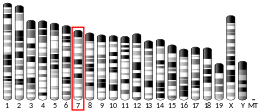NAPSA
| NAPSA | |||||||||||||||||||||||||
|---|---|---|---|---|---|---|---|---|---|---|---|---|---|---|---|---|---|---|---|---|---|---|---|---|---|
| Identifiers | |||||||||||||||||||||||||
| Aliases | NAPSA, KAP, Kdap, NAP1, NAPA, SNAPA, napsin A aspartic peptidase | ||||||||||||||||||||||||
| External IDs | MGI: 109365 HomoloGene: 68418 GeneCards: NAPSA | ||||||||||||||||||||||||
|
|||||||||||||||||||||||||
|
|||||||||||||||||||||||||
|
|||||||||||||||||||||||||
| Orthologs | |||||||||||||||||||||||||
| Species | Human | Mouse | |||||||||||||||||||||||
| Entrez |
|
|
|||||||||||||||||||||||
| Ensembl |
|
|
|||||||||||||||||||||||
| UniProt |
|
|
|||||||||||||||||||||||
| RefSeq (mRNA) |
|
|
|||||||||||||||||||||||
| RefSeq (protein) |
|
|
|||||||||||||||||||||||
| Location (UCSC) | Chr 19: 50.36 – 50.37 Mb | Chr 19: 44.57 – 44.59 Mb | |||||||||||||||||||||||
| PubMed search | |||||||||||||||||||||||||
|
|
|||||||||||||||||||||||||
Napsin-A is a protein that is encoded in humans by the NAPSA gene.
The activation peptides of aspartic proteinases plays role as inhibitors of the active site. These peptide segments, or pro-parts, are deemed important for correct folding, targeting, and control of the activation of aspartic proteinase zymogens. The pronapsin A gene is expressed predominantly in lung and kidney. Its translation product is predicted to be a fully functional, glycosylated aspartic proteinase precursor containing an RGD motif and an additional 18 residues at its C-terminus.
...
Wikipedia




